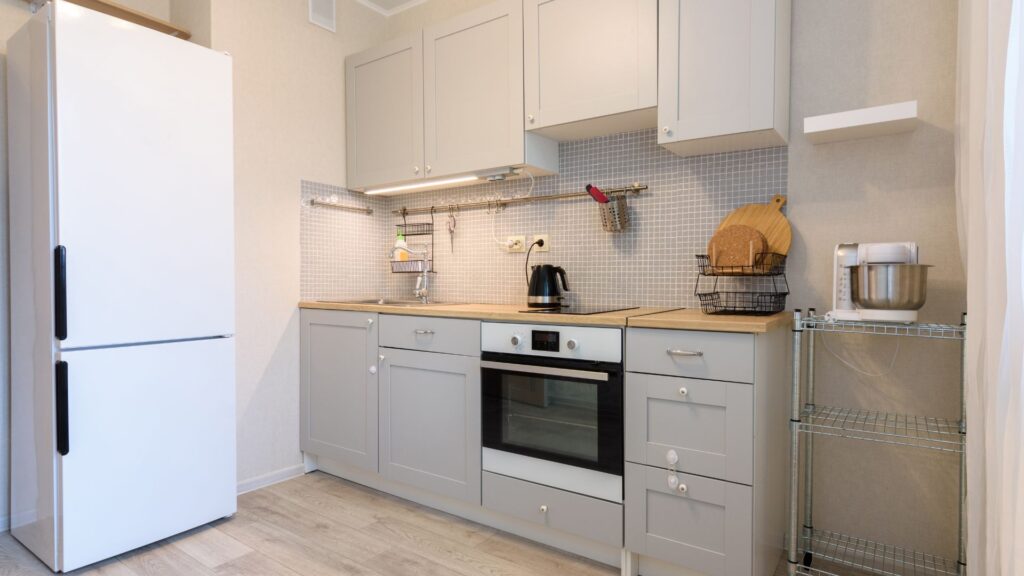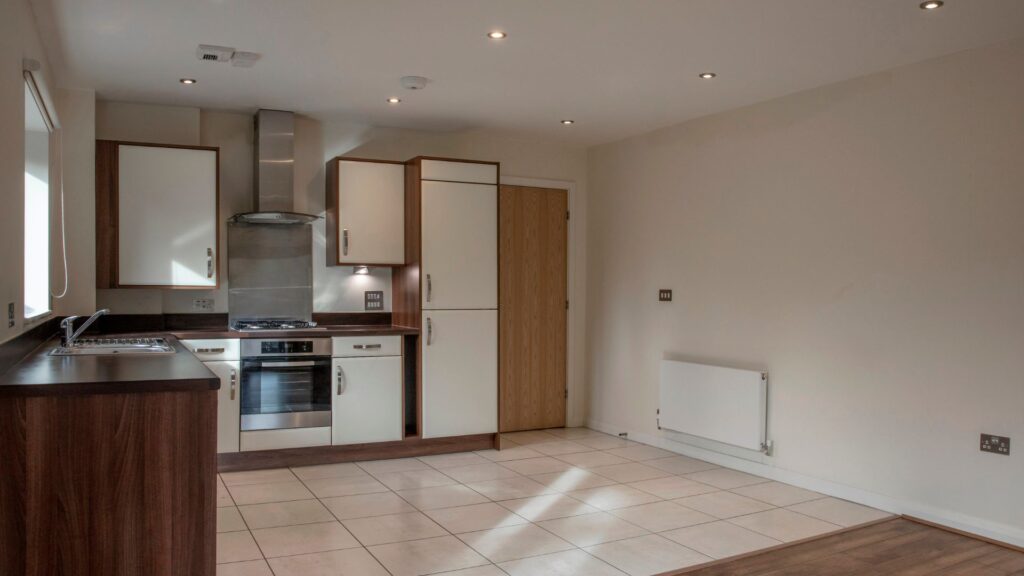Planning the layout for a kitchen renovation is an important step that can greatly influence the space’s functionality and aesthetic appeal. An intelligent design ensures that your kitchen is beautiful and practical, making daily tasks more efficient and enjoyable. The key to successful kitchen planning is understanding your needs, considering available space, and incorporating design principles that optimise workflow and storage.
Start by assessing your kitchen use and identifying the primary activities, such as cooking, dining, and entertaining. This will help you determine the most effective layout- a traditional work triangle between the stove, sink, and refrigerator- or a more modern open-concept design. Consider the placement of key appliances, counter space, and storage options to guarantee they complement your cooking habits and lifestyle. Factor in lighting, traffic flow, and accessibility to create an inviting and functional space.
Consider any structural limitations, such as walls, windows, and plumbing, as these will influence your layout decisions. Collaborating with a professional designer or architect can also offer insightful information and assist you in avoiding common pitfalls. By carefully planning your kitchen layout, you may design an area to suit your current needs, add value to your home, and enhance your overall quality of life.
Summary
Planning a kitchen renovation requires carefully considering combining beauty and usefulness to produce a useful, beautiful space suited to your lifestyle. Begin by assessing your kitchen usage and identifying key activities, then choose a layout that optimises workflow, such as the work triangle (sink, stove, refrigerator). Common layouts include L-shaped, U-shaped, galley, island, and peninsula kitchens, each suited to different spaces and needs.
Maximising storage, incorporating efficient lighting and ventilation, and selecting the right appliances and fixtures are crucial for a functional kitchen. Budget realistically, allocate funds for unexpected costs, and consider hiring professionals to ensure a smooth renovation process. Visualising the design with tools or a designer can help spot issues early.
Plan for future needs and stay flexible during the renovation, as unexpected challenges may arise. After completion, focus on careful organisation, regular maintenance, and enjoying your newly renovated kitchen.
Choosing The Right Kitchen Layout
The Work Triangle Concept
A well-established principle in kitchen design is the work triangle. This concept involves positioning the sink, stove, and refrigerator in a triangular formation, allowing efficient movement between these essential areas. The sides of the triangle should ideally measure between 1.2 to 2.7 meters, with the total distance ranging between 4 to 7.9 meters.
Common Kitchen Layouts
Different layouts suit different spaces and preferences:
- L-Shaped Kitchen:
- Ideal for small to medium-sized kitchens.
- Offers flexibility in terms of cabinetry and appliances.
- Works well in open-plan designs, blending seamlessly into living or dining areas.
- U-Shaped Kitchen:
- Provides ample countertop and storage space.
- Best suited for larger kitchens.
- Creates a dedicated cooking area, enhancing functionality.
- Galley Kitchen:
- Efficient for smaller spaces.
- Features two parallel countertops.
- Ideal for kitchens with limited space, reducing unnecessary movement.
- Island Kitchen:
- Suitable for larger spaces.
- The island is useful for various things, including additional prep space, a casual dining area, or even a place for a sink or stove.
- Encourages interaction and socialising within the kitchen.
- Peninsula Kitchen:
- Similar to an island kitchen but attached to a wall or another counter.
- Saves space while offering similar benefits to an island.
Planning For Storage And Organisation
Maximising Cabinet Space
Efficient storage is crucial in any kitchen. Consider the following strategies:
- Use deep drawers for pots and pans.
- Put in pull-out shelves so objects are easily accessible in the back of cabinets.
- Extend overhead cabinets to the ceiling to maximise storage and minimise dust accumulation.
Pantry Considerations
Incorporating a walk-in or cabinet-style pantry is essential for storing non-perishable food items and kitchen supplies. Pull-out shelves enhance accessibility, while baskets and containers help keep items organised.
Lighting And Ventilation
Task Lighting
Adequate illumination is essential for both practicality and ambience. Install task lighting under cabinets to illuminate work areas and reduce shadows. Pendant lights over an island or dining area can add style and focus light where it’s needed most.
Ambient Lighting
Ambient lighting provides general illumination, making the space feel welcoming. Recessed ceiling lights or a combination of wall sconces can achieve this. Consider dimmable options to adjust the lighting based on the time of day or mood.
Ventilation
Good ventilation is essential to remove cooking odours and maintain air quality. The most effective solution is a range hood that vents to the outside. Ensure the hood is appropriately sized for your stove and integrates well with the kitchen design.
Appliances And Fixtures
Selecting Appliances
When designing your kitchen’s layout, consider the positioning and size of appliances. Built-in appliances can create a sleek, cohesive look, while freestanding appliances offer flexibility. Ensure sufficient clearance around appliances like the oven and refrigerator for safe and efficient operation.
Fixtures And Fittings
The choice of fixtures, including taps, sinks, and handles, should complement the kitchen’s overall design. Consider pull-down taps for versatility, and opt for a deep sink if you frequently cook for large groups. The style of your fixtures can also enhance the kitchen’s aesthetic, whether modern or traditional.
Budgeting and Planning
Setting A Realistic Budget
Planning a budget is an essential component of kitchen renovation. Determine what you can afford before starting the project, and prioritise spending on key areas such as cabinetry, appliances, and countertops. It’s wise to allocate around 10-20% of your budget for unexpected costs.
Working With Professionals
Employing a qualified kitchen designer might be a worthwhile investment, especially if making significant changes to the layout. A designer can help maximise the functionality of your space and ensure that all kitchen elements work together harmoniously. When selecting a contractor, ensure they have experience with kitchen renovations and are familiar with local building codes.
Finalising Your Kitchen Layout
Visualising The Design
Before finalising your kitchen layout, consider creating a visual representation of the design. You can use online resources or collaborate with a designer who can produce a design for this 3D rendering. Visualising the design can help you spot potential issues and adjust before work begins.
Planning For The Future
When planning your kitchen layout, consider how your needs might change. Will your family grow? Do you plan to entertain more? Creating a room adaptable to future changes will ensure your kitchen remains functional for years.
Ensuring A Smooth Renovation Process
Creating A Timeline
Planning a realistic timeline for your renovation is crucial to avoid unnecessary stress and delays. Work with your contractor to establish a schedule that accounts for the time needed for each renovation phase, from demolition to final touches. Build in buffer time for any unexpected issues that may arise.
Managing The Renovation
Throughout the renovation process, it’s critical to maintain effective communication with your contractor and other experts. Frequent check-ins guarantee that the project remains on course and promptly addresses any issues. Keep the lines of communication open regarding any changes or updates to the original plan.
Preparing For The Unexpected
No renovation goes as planned, so preparing for the unexpected is important. Whether it’s an unforeseen structural issue or a material delay, a contingency plan will help you navigate any challenges. Staying flexible and willing to adjust as needed will make the process smoother.
Conclusion
Planning a kitchen renovation’s layout involves carefully considering both functionality and aesthetics. By taking the time to assess your space, define your needs, and work with professionals, you can design a stunning kitchen perfectly suited to your lifestyle. Staying flexible and prepared for surprises will make the renovation process smoother. The effort you invest in planning will result in a kitchen you’ll enjoy for years.
Frequently Asked Questions
How Can I Make My Kitchen Renovation More Sustainable?
Use energy-efficient appliances and eco-friendly materials, and consider recycling or donating old materials.
What’s The Best Way To Light A Kitchen?
Combine ambient, task, and accent lighting. Under-cabinet lights and pendant lights over islands are popular choices.
How Can I Create A Timeless Kitchen Design?
Stick to neutral colours, classic materials like wood or stone, and simple, clean lines in cabinetry and fixtures.
What Are The Benefits Of An Open-Concept Kitchen?
An open-concept kitchen allows for better flow, more natural light, and easier interaction with family and guests.
How Do I Choose The Right Kitchen Appliances?
When choosing appliances, consider your cooking habits, energy efficiency, and overall design aesthetic.



